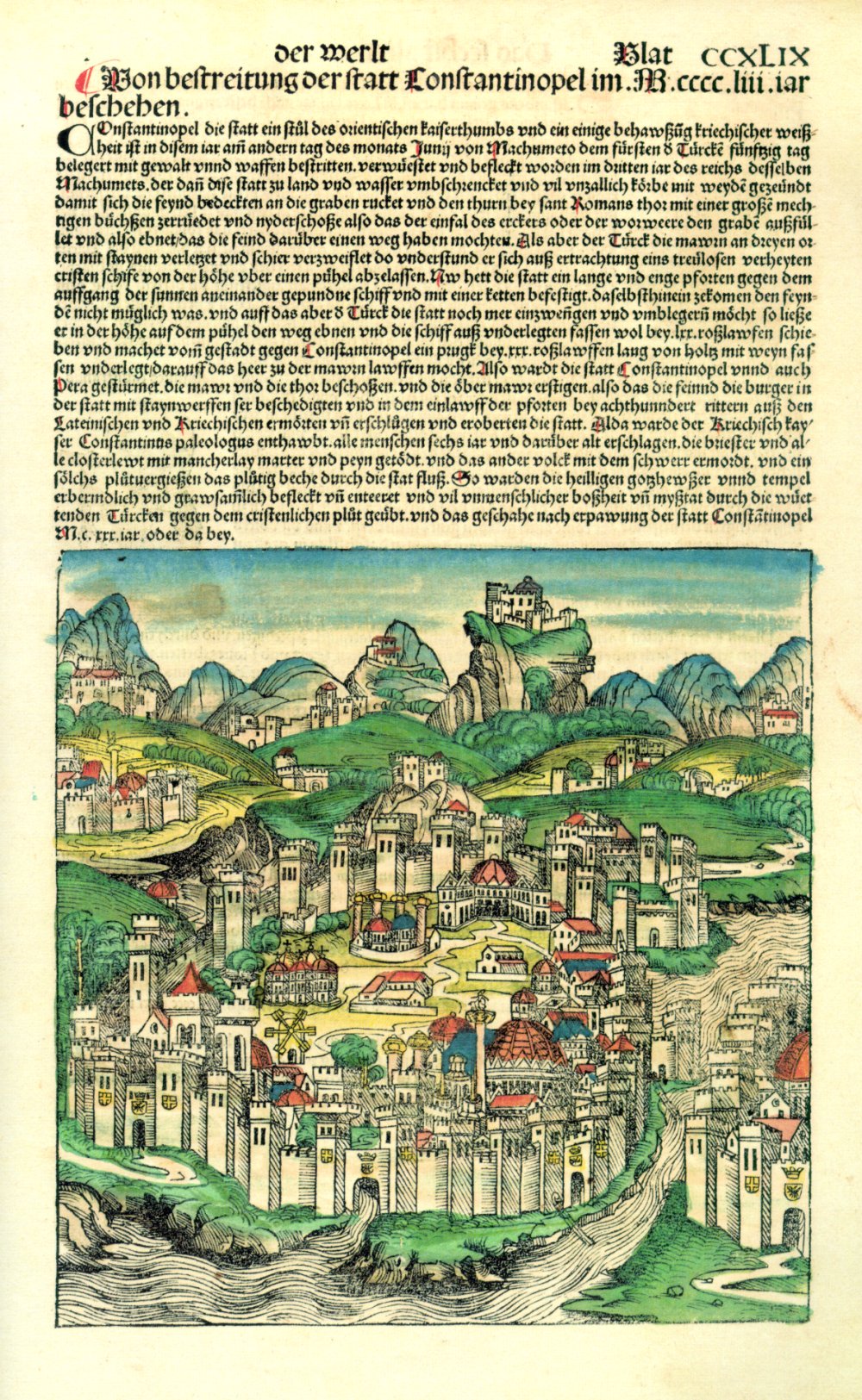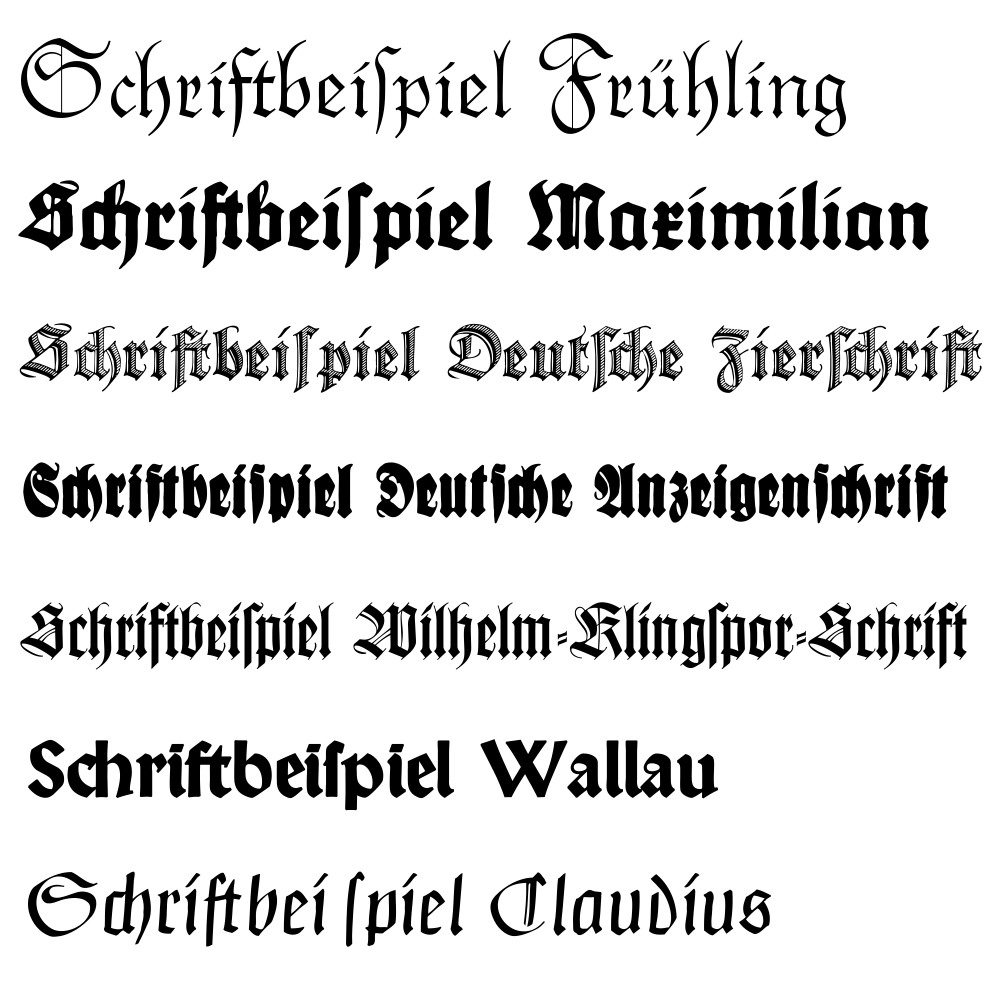|
Schwabacher
The German word Schwabacher (pronounced ) refers to a specific style of blackletter typefaces which evolved from Gothic Textualis (''Textura'') under the influence of Humanist type design in Italy during the 15th century. Schwabacher typesetting was the most common typeface in Germany, until it was replaced by Fraktur from the mid 16th century onwards. Etymology The term may derive from the Franconian town of Schwabach, where, in 1529, the Articles of Schwabach, a Lutheran creed, were adopted. The Articles became the basis of the 1530 Confessio Augustana, and possibly also promoted the use of Schwabacher types. Characteristics Similar to Rotunda, the rounded Schwabacher types were nearer to handwriting than the former Textualis style, though it also includes sharp edges. The lower-case ''g'' and upper-case ''H'' have particularly distinctive forms. In the context of German language texts, Schwabacher appeared vibrant and popular. History While the Latin Gutenberg Bible was ... [...More Info...] [...Related Items...] OR: [Wikipedia] [Google] [Baidu] |
Blackletter
Blackletter (sometimes black letter), also known as Gothic script, Gothic minuscule, or Textura, was a script used throughout Western Europe from approximately 1150 until the 17th century. It continued to be commonly used for the Danish, Norwegian, and Swedish languages until the 1870s, and for the German language until the 1940s, when Hitler's distaste for the supposedly "Jewish-influenced" script saw it officially discontinued in 1941. Fraktur is a notable script of this type, and sometimes the entire group of blackletter faces is incorrectly referred to as Fraktur. Blackletter is sometimes referred to as Old English, but it is not to be confused with the Old English language, which predates blackletter by many centuries and was written in the insular script or in Futhorc. Along with Italic type and Roman type, blackletter served as one of the major typefaces in the history of Western typography. Origins Carolingian minuscule was the direct ancestor of blackletter. Blacklett ... [...More Info...] [...Related Items...] OR: [Wikipedia] [Google] [Baidu] |
Typeface
A typeface (or font family) is the design of lettering that can include variations in size, weight (e.g. bold), slope (e.g. italic), width (e.g. condensed), and so on. Each of these variations of the typeface is a font. There are list of typefaces, thousands of different typefaces in existence, with new ones being developed constantly. The art and craft of designing typefaces is called ''type design''. Designers of typefaces are called ''type designers'' and are often employed by ''type foundry, type foundries''. In desktop publishing, type designers are sometimes also called ''font developers'' or ''font designers''. Every typeface is a collection of glyphs, each of which represents an individual letter, number, punctuation mark, or other symbol. The same glyph may be used for character (symbol), characters from different scripts, e.g. Roman uppercase A looks the same as Cyrillic uppercase А and Greek uppercase alpha. There are typefaces tailored for special applications, s ... [...More Info...] [...Related Items...] OR: [Wikipedia] [Google] [Baidu] |
Blackletter
Blackletter (sometimes black letter), also known as Gothic script, Gothic minuscule, or Textura, was a script used throughout Western Europe from approximately 1150 until the 17th century. It continued to be commonly used for the Danish, Norwegian, and Swedish languages until the 1870s, and for the German language until the 1940s, when Hitler's distaste for the supposedly "Jewish-influenced" script saw it officially discontinued in 1941. Fraktur is a notable script of this type, and sometimes the entire group of blackletter faces is incorrectly referred to as Fraktur. Blackletter is sometimes referred to as Old English, but it is not to be confused with the Old English language, which predates blackletter by many centuries and was written in the insular script or in Futhorc. Along with Italic type and Roman type, blackletter served as one of the major typefaces in the history of Western typography. Origins Carolingian minuscule was the direct ancestor of blackletter. Blacklett ... [...More Info...] [...Related Items...] OR: [Wikipedia] [Google] [Baidu] |
Schedel Konstantinopel
Hartmann Schedel (13 February 1440 – 28 November 1514) was a German historian, physician, humanist, and one of the first cartographers to use the printing press. He was born and died in Nuremberg. Matheolus Perusinus served as his tutor. Schedel is best known for his writing the text for the ''Nuremberg Chronicle'', known as ''Schedelsche Weltchronik'' (English: ''Schedel's World Chronicle''), published in 1493 in Nuremberg. It was commissioned by Sebald Schreyer (1446–1520) and Sebastian Kammermeister (1446–1503).Hartmann Schedule, Weltchronik, Kolorierte Gesamtausgabe von 1493, Einleitung und cementer Stephen Füssel, Weltbild Verlag Maps in the ''Chronicle'' were the first ever illustrations of many cities and countries. With the invention of the printing press by Johannes Gutenberg in 1447, it became feasible to print books and maps for a larger customer basis. Because they had to be handwritten, books had previously been rare and very expensive. Schedel was al ... [...More Info...] [...Related Items...] OR: [Wikipedia] [Google] [Baidu] |
Emphasis (typography)
In typography, emphasis is the strengthening of words in a text with a font in a different style from the rest of the text, to highlight them. It is the equivalent of prosody stress in speech. Methods and use The most common methods in Western typography fall under the general technique of emphasis through a change or modification of font: ''italics'', boldface and . Other methods include the alteration of LETTER CASE and as well as and *additional graphic marks*. Font styles and variants The human eye is very receptive to differences in "brightness within a text body." Therefore, one can differentiate between types of emphasis according to whether the emphasis changes the " blackness" of text, sometimes referred to as typographic color. A means of emphasis that does not have much effect on blackness is the use of ''italics'', where the text is written in a script style, or ''oblique'', where the vertical orientation of each letter of the text is slanted to the left o ... [...More Info...] [...Related Items...] OR: [Wikipedia] [Google] [Baidu] |
Nuremberg Chronicle
The ''Nuremberg Chronicle'' is an illustrated encyclopedia consisting of world historical accounts, as well as accounts told through biblical paraphrase. Subjects include human history in relation to the Bible, illustrated mythological creatures, and the histories of important Christian and secular cities from antiquity. Finished in 1493, it was originally written in Latin by Hartmann Schedel, and a German version was translated by Georg Alt. It is one of the best-documented early printed books—an incunabulum—and one of the first to successfully integrate illustrations and text. Latin scholars refer to it as the Liber Chronicarum (''Book of Chronicles'') as this phrase appears in the index introduction of the Latin edition. English-speakers have long referred to it as the ''Nuremberg Chronicle'' after the city in which it was published. German-speakers refer to it as ''Die Schedelsche Weltchronik'' (''Schedel's World History'') in honour of its author. Production Two Nurember ... [...More Info...] [...Related Items...] OR: [Wikipedia] [Google] [Baidu] |
Albrecht Dürer
Albrecht Dürer (; ; hu, Ajtósi Adalbert; 21 May 1471 – 6 April 1528),Müller, Peter O. (1993) ''Substantiv-Derivation in Den Schriften Albrecht Dürers'', Walter de Gruyter. . sometimes spelled in English as Durer (without an umlaut) or Duerer, was a German painter, printmaker, and theorist of the German Renaissance. Born in Nuremberg, Dürer established his reputation and influence across Europe in his twenties due to his high-quality woodcut prints. He was in contact with the major Italian artists of his time, including Raphael, Giovanni Bellini, and Leonardo da Vinci, and from 1512 was patronized by Emperor Maximilian I. Dürer's vast body of work includes engravings, his preferred technique in his later prints, altarpieces, portraits and self-portraits, watercolours and books. The woodcuts series are more Gothic than the rest of his work. His well-known engravings include the three '' Meisterstiche'' (master prints) ''Knight, Death and the Devil'' (1513), '' Sain ... [...More Info...] [...Related Items...] OR: [Wikipedia] [Google] [Baidu] |
Apocalypse (Dürer)
The ''Apocalypse'', properly ''Apocalypse with Pictures'' ( la, Apocalipsis cum figuris), is a series of fifteen woodcuts by Albrecht Dürer published in 1498 depicting various scenes from the Book of Revelation, which rapidly brought him fame across Europe. These woodcuts likely drew on theological advice, particularly from Johannes Pirckheimer, the father of Dürer's friend Willibald Pirckheimer. Work on the series started during Dürer's first trip to Italy (1494–95), and the set was published simultaneously as a book with 15 pages of biblical text facing the 15 illustrations. in Latin and German at Nuremberg in 1498, at a time when much of secular Europe feared an invasion of the Ottoman Empire and Christian Europe anticipated a possible Last Judgment in the year 1500. Dürer was the publisher and seller of this series, and became the first artist to publish a book and create a copyright. Considering the 15 woodcuts, '' The Four Horsemen of the Apocalypse'' (c. 1497� ... [...More Info...] [...Related Items...] OR: [Wikipedia] [Google] [Baidu] |
Luther Bible
The Luther Bible (german: Lutherbibel) is a German language Bible translation from Latin sources by Martin Luther. The New Testament was first published in September 1522, and the complete Bible, containing the Old and New Testaments with Apocrypha, in 1534. Luther continued to make improvements to the text until 1545. It was the first full translation of the Bible into German which made use of Greek texts, not just their Latin Vulgate translations. However, the updated 2017 translation of the Luther Bible published by the Evangelical Church in Germany notes that "Luther translated according to the Latin text". Luther did not speak Greek, Hebrew, or Aramaic and relied heavily on other scholars for assistance, particularly Melanchthon. One of the textual bases of the New Testament translation was the Greek version recently published by the Dutch Catholic humanist Erasmus of Rotterdam and called the Novum Instrumentum omne. The project absorbed Luther's later years. Thanks to th ... [...More Info...] [...Related Items...] OR: [Wikipedia] [Google] [Baidu] |
Nazi Party
The Nazi Party, officially the National Socialist German Workers' Party (german: Nationalsozialistische Deutsche Arbeiterpartei or NSDAP), was a far-right politics, far-right political party in Germany active between 1920 and 1945 that created and supported the ideology of Nazism. Its precursor, the German Workers' Party (; DAP), existed from 1919 to 1920. The Nazi Party emerged from the Extremism, extremist German nationalism, German nationalist, racism, racist and populism, populist paramilitary culture, which fought against the communism, communist uprisings in post–World War I Germany. The party was created to draw workers away from communism and into nationalism. Initially, Nazi political strategy focused on anti–big business, anti-bourgeoisie, bourgeois, and anti-capitalism, anti-capitalist rhetoric. This was later downplayed to gain the support of business leaders, and in the 1930s, the party's main focus shifted to Antisemitism, antisemitic and Criticism of ... [...More Info...] [...Related Items...] OR: [Wikipedia] [Google] [Baidu] |
Martin Bormann
Martin Ludwig Bormann (17 June 1900 – 2 May 1945) was a German Nazi Party official and head of the Nazi Party Chancellery. He gained immense power by using his position as Adolf Hitler's private secretary to control the flow of information and access to Hitler. He used his position to create an extensive bureaucracy and involve himself as much as possible in the decision making. Bormann joined a paramilitary ''Freikorps'' organisation in 1922 while working as manager of a large estate. He served nearly a year in prison as an accomplice to his friend Rudolf Höss (later commandant of Auschwitz concentration camp) in the murder of Walther Kadow. Bormann joined the Nazi Party in 1927 and the ''Schutzstaffel'' (SS) in 1937. He initially worked in the party's insurance service, and transferred in July 1933 to the office of Deputy Führer Rudolf Hess, where he served as chief of staff. Bormann gained acceptance into Hitler's inner circle and accompanied him everywhere, providin ... [...More Info...] [...Related Items...] OR: [Wikipedia] [Google] [Baidu] |




.png)




